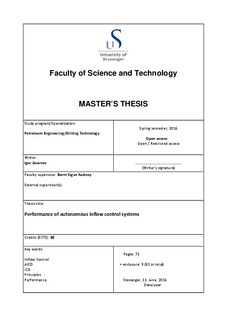| dc.description.abstract | The first passive Inflow Control Devices (ICDs), were introduced in the early 1990’s. Their task is to provide an additional choking effect in long reach horizontal wells and to eliminate heel-toe effect. There are several passive inflow control devices available today starting from the nozzle, helical/channel and tube type. Since none of them is able to provide additional choking effect, when the breakthrough occurs, the more advanced Autonomous Inflow Control Devices (AICDs) had to be developed. The primary function of any AICD is to be able to provide additional pressure drop when the breakthrough occurs, and unwanted fluids start flowing. There are some differences in the functionality and principles between available AICDs on todays market, and every device has its own range of abilities. Some of them are water and/or gas stopper valve, and some of them are flow controller valves. Water and gas stopper AICDs, are able to autonomously choke production of water and/or gas when it starts flowing, and allow oil producing zones to produce more easily, and most of them have the flow control ability in addition. On the other hand, flow controller AICDs are only regulating the flow rate, in order to keep it relatively constant or in predetermined limits. As a result, all of them have slightly different performance characteristics for different fluid types and flow properties.
This thesis covers the AICDs design, principles and performance characteristic of some of the available AICDs today. Principles on which their design is based on varies, some are implementing viscosity effects (Poiseuille’s law), some density effect (Bernoulli’s law), Bouyancy, Pressure sensitivity, etc. Based on that, they can be categorized as mainly viscosity dependent devices, pressure and flow rate sensitive devices, and buoyancy sensitive devices. It is shown how the performance characteristics vary between them, depending on the flowing fluid properties.
The results developed in this thesis, provide an insight in the available AICDs and their principles and performance. Therefore, it can be helpful in the process of making the decision on what is the best possible solution for inflow control system in the producing well. | nb_NO |

